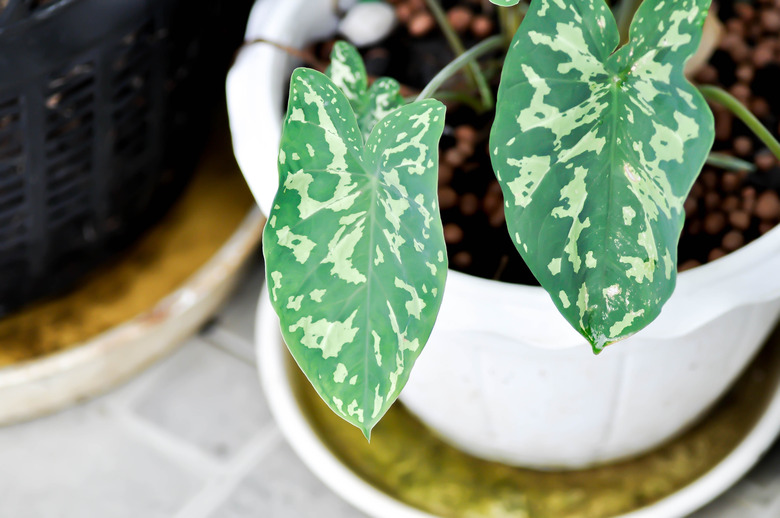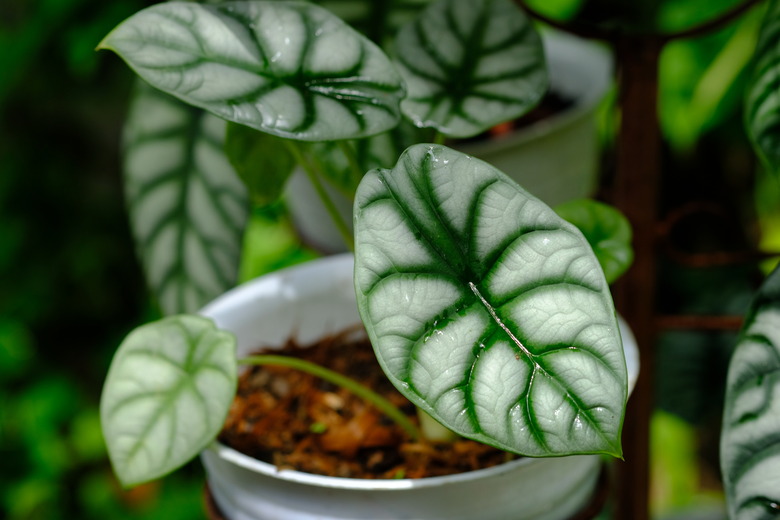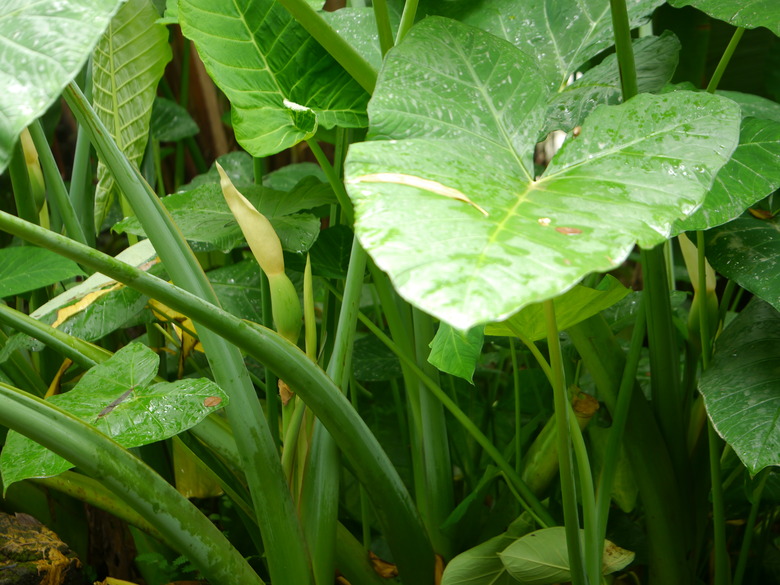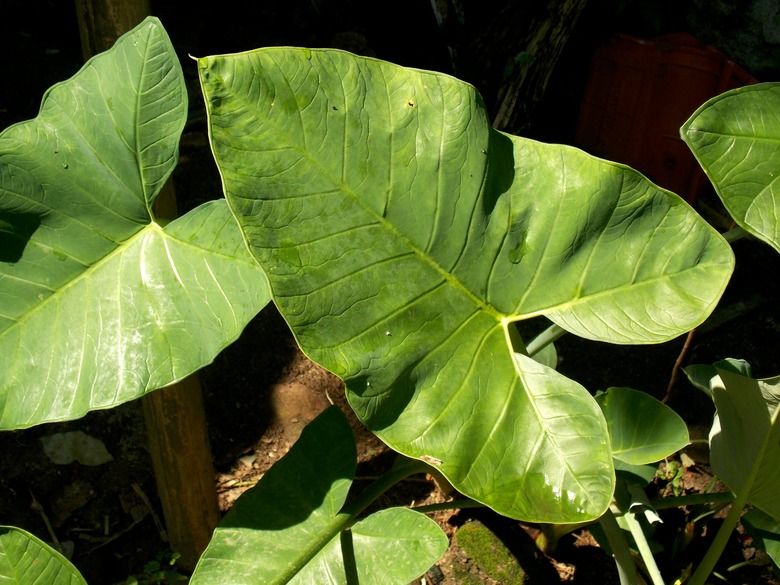How To Grow Elephant Ears Indoors
Growing elephant ears indoors does not require a large investment of time or energy, but it does require a significant amount of space. Several species share the common name "elephant ears," all of which have very large, heart-shaped leaves that dominate their growing space.
Although all elephant ear varieties can be grown as indoor foliage plants, some types are better suited to indoor environments than others.
Warning
One factor that you must consider before growing elephant ears as houseplants is their toxicity. They contain oxalates that can cause serious illness or death if consumed, so they pose a serious hazard to pets and children.
Elephant Ear Varieties
There are three main types of elephant ear plants: edible taro, giant taro and tannia plants. All grow from tubers and share a similar appearance, but there are differences in size and leaf shape that distinguish one from another.
Edible Taro or Caladium Plants
Edible taro or caladium (Colocasia esculenta) grows best in USDA plant hardiness zones 8a to 11b, where it can reach a mature height of 3 to 6 feet with a 3- to 6-foot spread.
It is typically grown outdoors due to its size and spreading habit, but cultivars such as Black Magic (Colocasia esculenta 'Black Magic') and Rhubarb (Colocasia esculenta 'Rhubarb') make highly ornamental houseplants because of their bold, colorful foliage.
Giant Taro or Alocasia Plants
Sometimes called giant taro or alocasia plants, elephant ears (Alocasia spp., zones 10a to 12b) can reach a mature height of 2 to 9 feet, but they typically have a more upright growth habit than edible taro.
The dwarf cultivar Low Rider (Alocasia 'Low Rider') makes a space-conscious choice for indoor growing because of its small size, while Yucatan Princess (Alocasia 'Yucatan Princess') is a bold and eye-catching choice because of its greenish-black leaves.
Tannia or Xanthosoma Plants
Tannia (Xanthosoma sagittifolium) is another variety of elephant ear plant that is occasionally grown as an ornamental plant. It grows outdoors in USDA plant hardiness zones 8 to 10 but will also grow well indoors, if given plenty of space, warmth and light.
Tannia leaves share a similar appearance to those of the giant taro and edible taro, but they have a slightly more arrow-like shape. As indoor plants, they typically grow to just 2 to 4 feet in height.
Growing Elephant Ears Indoors
Growing elephant ear plants indoors is simple to do because they are low maintenance. However, they must be grown under the right condition to keep them healthy and disease-free.
**Sunlight Exposure:** Different elephant ears plants need different light levels. Edible taro needs full sun to partial shade, while giant taro will tolerate full shade or partial sun exposure. Tannia will tolerate a range of sunlight levels from full sun to deep shade.
Indoors, position these plants near an eastern or western window. Tannia and giant taro will also tolerate being positioned near a north-facing window where sunlight is dim.
Tip
Direct sunlight near a south-facing window can be too intense, so choose a south-facing window with some light afternoon shade.
**Pots and Soil:** Elephant ear plants typically need a heavy, large container to support the weight of their very large leaves. Choose a pot that is no more than an inch or two larger than the existing pot, because soil in an oversized pot can hold too much water, which increases the chance of root rot.
Use a large pot made of plastic or clay with drainage holes at the bottom. Standard potting soil enriched with peat moss or perlite is the best soil for elephant ears, although soilless potting mix can also be used.
**Humidity Levels:** Elephant ears grow best when humidity levels stay above 50%, but they will tolerate lower levels without suffering any serious harm. However, high humidity levels will decrease the odds of spider mite infestations.
Set your potted elephant ear plant on a shallow tray filled with wet pebbles to raise humidity around the leaves. Misting the foliage regularly will also help raise humidity.
Caring for Elephant Ears Indoors
Indoor elephant ear plants need less care than other types of tropical plants, but they still need some regular attention to keep them looking good.
Watering Requirements
Elephant ears need moist soil during the growing season, but they should be allowed to dry out slightly between waterings to keep their roots healthy. **Provide a deep drink of water whenever the soil feels dry on the surface,** watering until the excess drains from the bottom of the pot.
In winter, let the soil dry out in the top inch or so between waterings. Resume normal watering in spring once temperatures warm.
Fertilizer Needs
Elephant ear plants grow year round, although growth slows significantly during the winter months when the plant enters a state of dormancy. Fertilize only during the active growing season from spring until just after midsummer, with a diluted solution to prevent root burn.
Use balanced liquid fertilizer such as 15-15-15 diluted to half or one-quarter of its recommended strength. Apply the fertilizer to tannia plants every month, or feed every two months, if you are growing a giant taro.
Stop feeding once temperatures dip below 60°F in autumn, and resume feeding in spring.
Pruning and Repotting
Elephant ear plants often develop brown or damaged leaves that should be removed to tidy the plant's appearance. Snip off the damaged leaves as close to the soil as possible using sharp pruning shears that have been wiped down with rubbing alcohol. Wear rubber gloves when pruning these plants, and wash your hands and shears afterward.
Repot elephant ears every few years, once they fill up their old pot with new leaves. Use rich, well-draining soil and a pot with drainage holes that is an inch or two larger than the old pot. Repot them in spring.
Troubleshooting Elephant Ear Plants
Serious problems are rare if you grow elephant ears under the right growing conditions and with the right care. Overwatering and strong, direct sun are two common culprits of problems such as damaged or discolored foliage, because both factors can stress the plant.
If your elephant ear plant develops discolored or damaged foliage, prune it off. Allow your plant to dry out between waterings and provide it with bright, indirect light rather than strong sunlight.
References
- University of Wisconsin-Madison: Elephant Ears (Colocasia, Alocasia, and Xanthosoma
- Logee's Plants: Cultural Information-Alocasia
- Logee's Plants: Cultural Information-Xanthosoma
- North Carolina State Cooperative Extension: Alocasia
- North Carolina State Cooperative Extension: Colocasia
- Missouri Botanical Garden: Xanthosoma




